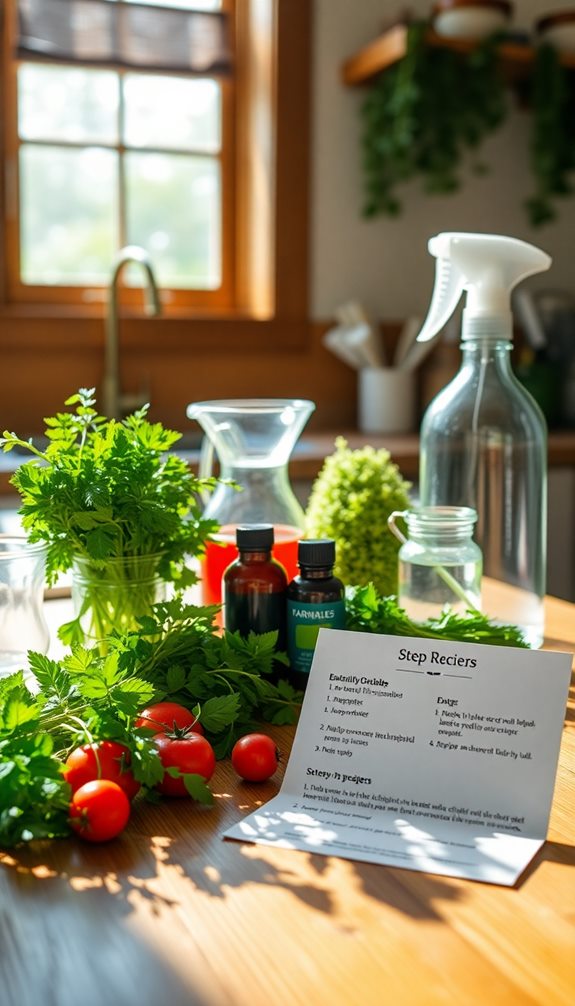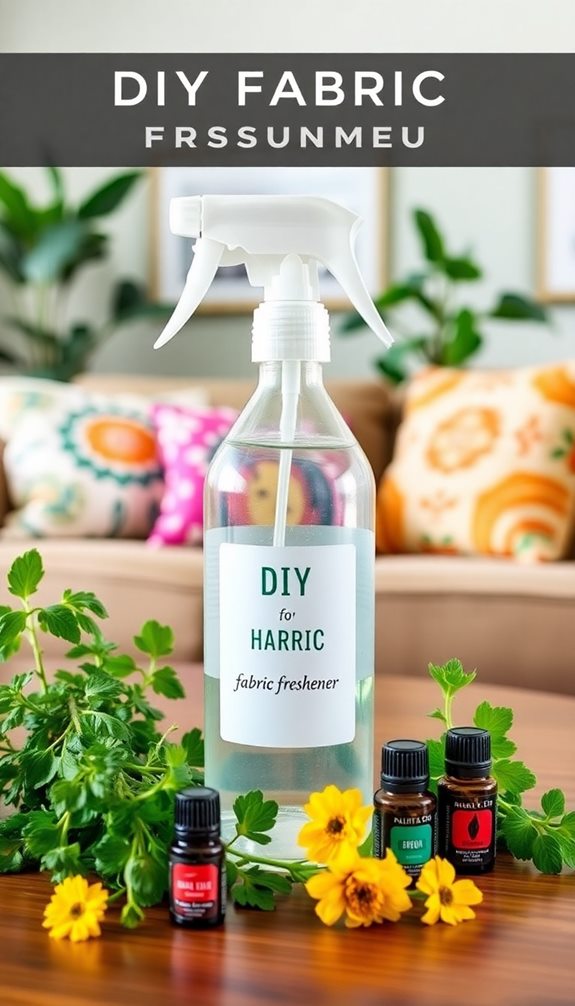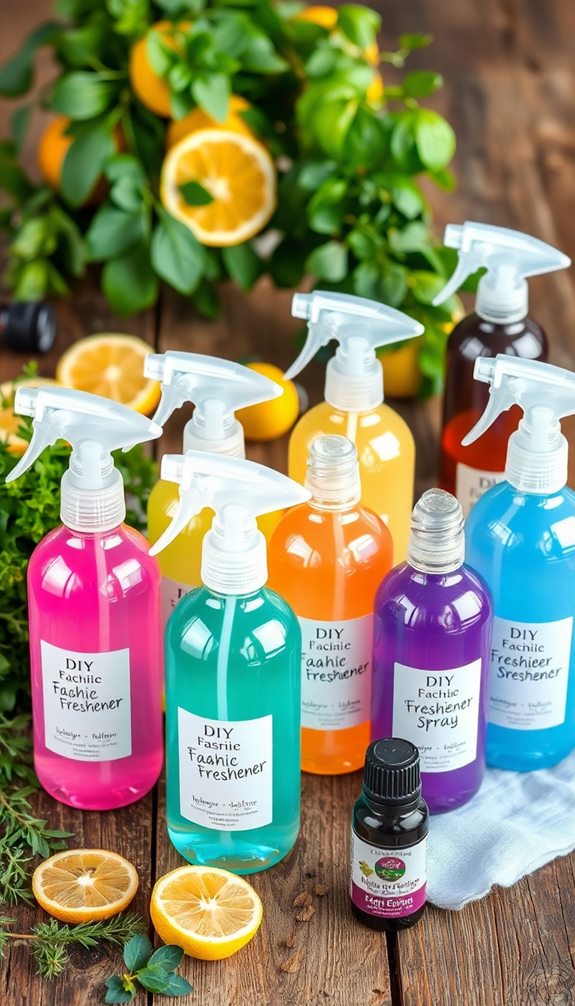Creating your own fabric freshener spray is easy and cost-effective. Start with 2 cups of distilled water, 1 cup of rubbing alcohol, and 10-30 drops of your favorite essential oils. Combine the alcohol and water in a glass spray bottle, add the essential oils, and give it a gentle shake. This DIY option is non-toxic and customizable, allowing you to personalize scents while keeping your home fresh. Remember to test on a small fabric area first. If you're curious about variations and extra tips for this handy spray, keep going to discover more!
Benefits of DIY Fabric Fresheners
DIY fabric fresheners offer several compelling benefits that make them a smart choice for anyone looking to refresh their home.
First off, they're cost-effective, especially in larger households. You can use inexpensive natural ingredients like rubbing alcohol and essential oils, saving money while keeping your fabric fresh. Additionally, opting for non-toxic cleaners allows you to eliminate odors without exposing your family to harmful chemicals found in many commercial products. By choosing a DIY fabric freshener, you're fostering a healthier home environment.
Plus, essential oils not only provide delightful scents but can also reduce allergens and bacteria.
Customizability is a key perk, allowing you to tailor the scent and potency to match your personal preferences. Whether you love the calming aroma of lavender or the invigorating scent of eucalyptus, you can create a freshener that suits you perfectly.
Lastly, making your own fabric fresheners contributes to eco-friendly practices. By minimizing plastic waste from commercial product packaging, you're taking a step toward sustainable living.
Embrace the benefits of DIY fabric fresheners and enjoy a fresher, healthier home!
Essential Ingredients for Fabric Spray
To create your fabric spray, you'll need a few key ingredients that work together to freshen up your fabrics.
Start with rubbing alcohol for odor neutralization, as it effectively combats unpleasant smells while being an eco-friendly option.
Additionally, don't forget to choose essential oils that suit your scent preference and can add antimicrobial benefits, such as those found in natural cleaning practices.
Key Ingredients Overview
Creating your own fabric freshener spray is a simple yet effective way to keep your fabrics smelling great. The primary ingredients for your homemade fabric freshener include 2 cups of distilled water and 1 cup of rubbing alcohol.
Rubbing alcohol acts as an excellent odor neutralizer, helping to eliminate unpleasant smells from your textiles.
To give your spray a delightful scent, add essential oils of your choice—lavender, tea tree, or lemon are popular options. You'll want to use between 2 to 20 drops, depending on how strong you prefer the fragrance.
For storage, a glass spray bottle is recommended, especially if you choose citrus-based essential oils, as they can react with plastic.
Using a funnel can simplify the transfer of your ingredients into the spray bottle, making the process cleaner and more efficient.
Essential Oil Selection
When choosing essential oils for your fabric freshener spray, it's crucial to select 100% pure oils to guarantee effectiveness and prevent any residue on your fabrics. Popular choices like lavender, tea tree, eucalyptus, and lemon not only provide delightful scents but also boast antimicrobial properties, making them excellent for your homemade fabric spray.
If you have pets, verify the oils you pick are safe for them. Lavender and cardamom are generally considered pet-friendly options, allowing you to create a natural fabric freshener that's safe for the whole family.
Remember to use essential oils in moderation—aim for about 10-20 drops per cup of liquid. This balance will deliver a pleasant fragrance without overpowering your space.
One of the joys of crafting your fabric refresher is the ability to experiment with customized fragrance blends. Feel free to mix different essential oils to create a personalized scent experience that reflects your preferences.
With the right selection of essential oils, you'll enjoy a fresh-smelling home that's inviting and comforting!
Step-by-Step Recipe Instructions

Mixing your own fabric freshener spray is simple and takes just a few minutes. To create your DIY refresher, start by gathering your ingredients: 1/4 cup of rubbing alcohol, 2 tablespoons of baking soda, and 1.5 cups of water. Grab a glass spray bottle for mixing.
You can also consider enhancing your fabric freshener with customizable scents by using different essential oils to match your preference.
Begin by adding the rubbing alcohol and baking soda to the bottle. You'll notice some fizzing—this reaction activates the deodorizing properties of the baking soda.
Once the fizzing subsides, add 30 drops of your chosen essential oils for a pleasant fragrance. Next, fill the rest of the bottle with water, leaving a little space at the top. Shake gently until the baking soda dissolves completely.
Before you use your homemade spray, remember to test it on a small, inconspicuous area of fabric to verify it won't stain.
After testing, give the bottle a good shake before each use, as the ingredients may separate over time. This simple recipe will help keep your fabrics smelling fresh and inviting!
Enjoy your DIY fabric refresher and the delightful aroma it brings to your home.
Usage Tips and Best Practices
When using your DIY fabric freshener spray, remember to shake the bottle before each use for an even mix.
For an eco-friendly approach, consider using natural cleaning agents like vinegar or essential oils for added antibacterial properties and a pleasant scent, as highlighted in green cleaning methods.
Store it in a cool, dark place to keep the ingredients fresh, and always test it on a hidden area first to avoid any surprises.
With these tips, you can enjoy a clean, inviting scent without compromising your fabrics.
Application Techniques
To achieve the best results with your DIY fabric freshener spray, start by shaking the bottle thoroughly before each use. This guarantees the ingredients, especially the essential oils, are well combined for maximum effectiveness.
Before applying the fabric refresher spray, it's wise to test the spray on a small, inconspicuous area of fabric. This way, you can check for compatibility and prevent any potential staining or damage.
When you're ready to freshen up your space, lightly mist the fabric rather than soaking it. This method allows the DIY fabric spray to dry naturally and evenly, avoiding excess moisture that could lead to mildew or damage.
Focus on high-traffic areas like living rooms and entryways to maintain a consistently fresh aroma throughout your home.
After use, remember to store the spray in a cool, dark place. Proper storage helps prolong the potency of the essential oils, guaranteeing your natural fabric refresher remains effective over time.
Storage Recommendations
Storing your DIY fabric freshener spray properly is vital for maintaining its effectiveness and longevity. First, always use a glass spray bottle to avoid any chemical reactions with the ingredients, especially if you're using citrus-based essential oils, which can break down plastic over time.
Place your homemade fabric refresher in a cool, dark location to preserve the essential oils and prevent degradation. Keeping it away from direct sunlight and heat sources is important, as these conditions can alter both the scent and potency of your mixture.
Be certain to label your spray bottle clearly with the contents and the date of preparation. This helps you avoid accidental use of old or expired mixtures.
Additionally, regularly check the nozzle for clogs. A clean nozzle guarantees a fine mist for even application on your fabrics, enhancing the overall effectiveness of the spray.
Safety Precautions
While using your DIY fabric freshener spray, it's important to take some safety precautions to guarantee both the integrity of your fabrics and your health. Start by testing your DIY fabric refresher on a small, inconspicuous area of the fabric. This helps ascertain compatibility and prevent any staining or damage.
Always shake the spray bottle well before each use to mix the ingredients thoroughly.
When working with essential oils, do your research first. Some oils can pose health risks, especially around pets and children, so choosing safe options is vital. Additionally, avoid spraying directly onto delicate fabrics like suede or silk; the moisture may cause damage or discoloration.
Storing fabric refresher properly is also key. Keep it in a cool, dark place to maintain the potency and effectiveness of the essential oils.
Versatile Applications for Fabric Spray

Versatility is one of the greatest strengths of DIY fabric freshener sprays, making them an essential addition to your home care routine. You can use a natural homemade fabric refresher spray on various surfaces, enhancing freshness throughout your space.
For instance, incorporating regular cleaning schedules, as suggested in preventive measures for future hair build-up, can keep your fabrics fresher for longer. Start with upholstery; a quick spray on couches, chairs, and curtains can revitalize them, but remember to test a small area first for compatibility.
Don't forget about your bedding! Spraying sheets and pillows creates a calming atmosphere that promotes relaxation and better sleep.
Your closets and drawers also benefit from fabric fresheners, helping maintain freshness in clothing and linens, especially those seasonal items you seldom use.
Lightly spritzing carpets and rugs can eliminate stale odors, but confirm you let the area air dry for best results.
Finally, when it comes to your vehicle, using a DIY fabric refresher spray can effectively remove food, pet, or smoke odors from car upholstery, enhancing your overall driving experience.
With these versatile applications, you'll find it easy to keep your home and car smelling fresh and inviting.
Choosing Quality Essential Oils
How do you choose the right essential oils for your DIY fabric freshener spray? Start by selecting 100% pure essential oils to guarantee the fragrance is natural and free from synthetic additives that could leave residues on your fabrics.
Look for oils labeled as "therapeutic grade," as they typically offer higher quality, better scent profiles, and additional therapeutic benefits.
To test the quality of essential oils, drop a small amount on a piece of paper; pure oils should evaporate completely within an hour without leaving oily marks.
Popular choices for fabric fresheners include lavender, lemon, and eucalyptus. These not only smell delightful but also possess antibacterial properties, making your home fresher and cleaner.
Don't forget about pet safety! Some essential oils can be harmful to animals. Before using any oil, check reliable resources or consult your veterinarian to guarantee the oils you choose are safe for homes with pets.
Community Feedback and Variations

As you immerse yourself in the world of DIY fabric fresheners, you'll quickly notice that community feedback plays an essential role in refining your recipes. Many users emphasize the effectiveness of using high-proof alcohol as a base for your homemade fabric freshener, reporting excellent odor neutralization.
Incorporating natural ingredients like vinegar or baking soda can further enhance the freshness of your sprays, as natural odor control methods consistently yield positive results. Adding baking soda is another popular variation; it not only enhances deodorizing capabilities but also minimizes potential residue on your fabrics.
Experimenting with different essential oil blends is a fun way to find personalized scents. Popular combinations like lavender and lemon or eucalyptus and tea tree often get high marks from the community.
When selecting essential oils, remember to reflect on pet-friendly options. Users frequently share tips on safe essential oil usage, urging you to consult veterinarians to ascertain the oils you choose are safe for your furry friends.
The community thrives on sharing successful modifications and alternative ingredients, creating a collaborative space for DIY enthusiasts. By incorporating these insights and variations, you can enhance your DIY fabric sprays, making your home smell fresh and inviting while keeping it safe for everyone.
Conclusion
Incorporating DIY fabric fresheners into your home routine not only saves you money but also reduces exposure to harsh chemicals—over 70% of commercial air fresheners contain potentially harmful ingredients! By using simple, natural ingredients, you can create a fresh, inviting atmosphere while personalizing scents to your preference. So, gather your essential oils and get started on your own fabric spray today. Your home will smell fantastic, and you'll feel great knowing it's eco-friendly!